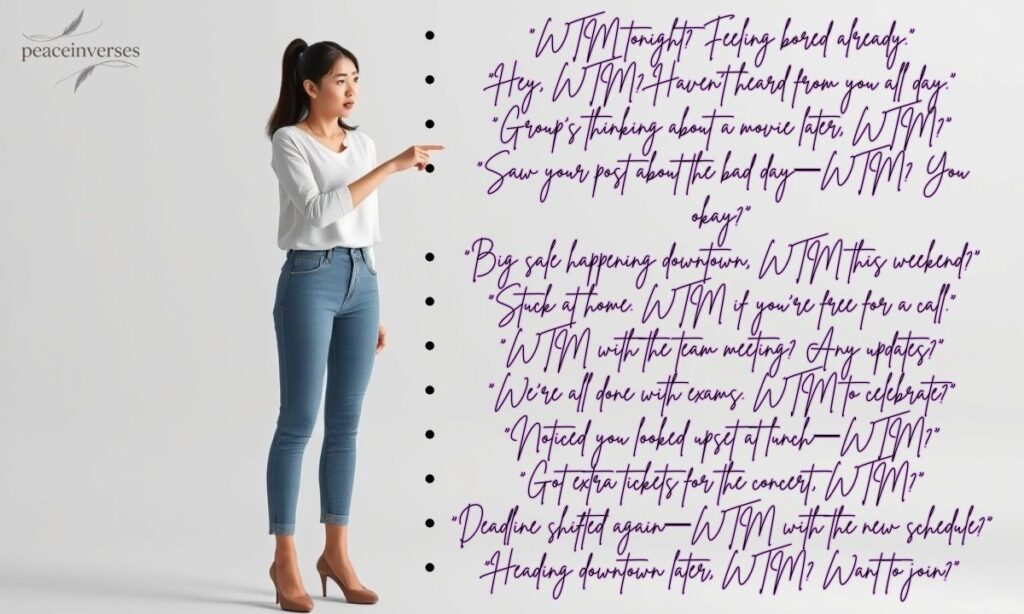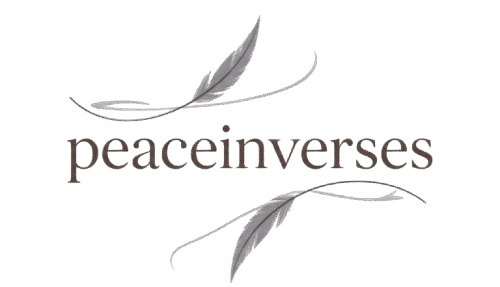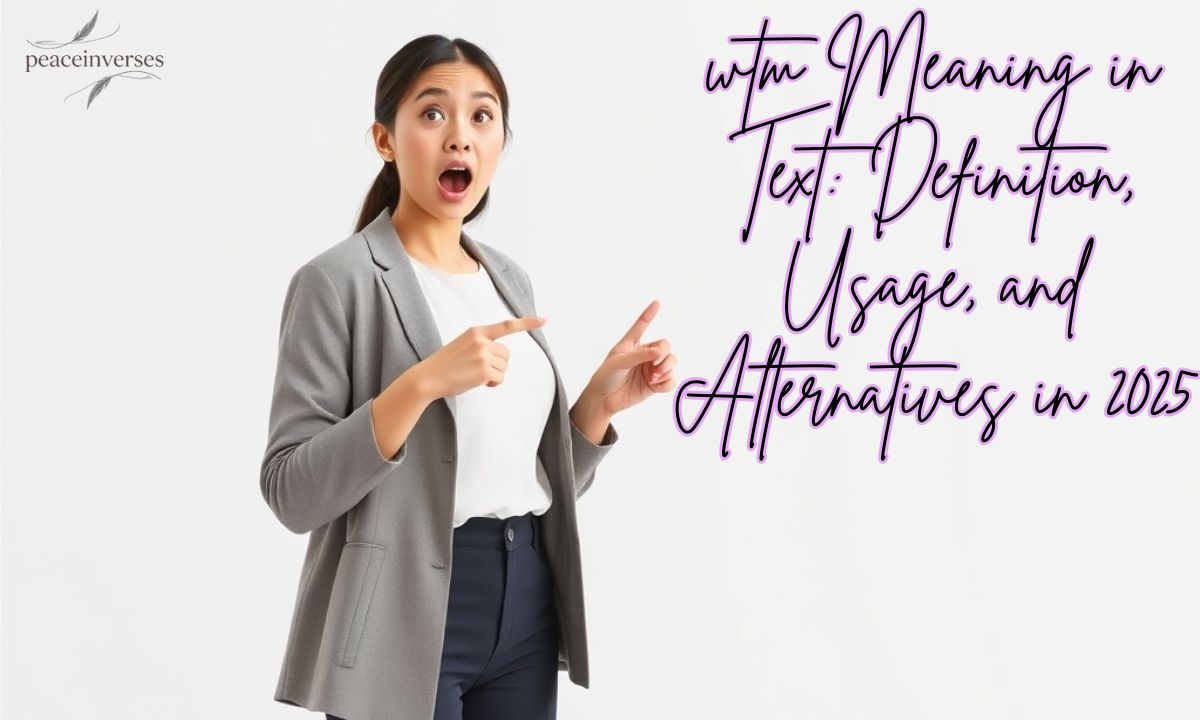Texting keeps changing, and new slang shows up every year. Among the quick phrases people drop online, WTM stands out as one you’ll spot in group chats, comments, and late-night messages. It’s short, casual, and often sparks curiosity.
In 2025, WTM has become a go-to phrase for many. Its popularity reflects how people like to keep conversations quick and light. Knowing how and when to use it can make texting smoother and more natural.
What Does “WTM” Mean in Text?
WTM is a small acronym with a big impact on modern texting. People use it in quick messages to save time and keep things casual. You’ll see it in group chats, social media stories, and even private conversations.
Its meaning depends on the situation, not just the letters themselves. A friend might type it to start plans, while someone else could use it to check if you’re okay. The key is reading the mood of the message.
WTM reflects how language keeps evolving in the digital age. It’s proof that short phrases can hold more than one meaning. Understanding it helps avoid confusion and keeps your replies natural.
Why Understanding “WTM” Matters in 2025
In 2025, slang like WTM moves fast and spreads even faster. Missing its meaning can make you feel left out of casual or online conversations. It’s become part of daily texting habits for many people.
Knowing what WTM stands for helps you communicate clearly. It lets you respond in a way that matches the other person’s tone, whether friendly, curious, or concerned. This makes conversations smoother and more genuine.
Understanding WTM is also about staying socially aware. If you use or reply to it correctly, you show that you’re in touch with modern communication trends.
- Avoids confusion: You won’t misread a friendly message as something serious.
- Builds connection: Using familiar slang can make you feel closer to friends or peers.
- Saves time: A short response keeps chats quick without losing meaning.
- Shows awareness: Staying updated with new slang reflects adaptability and social insight.
How Tone and Context Change Meaning
Tone plays a huge role in shaping how WTM is understood. A cheerful text late on a weekend feels different from one sent quietly after seeing a sad post. Timing and punctuation add to the meaning.
Context guides whether the phrase feels playful or serious. The same three letters can spark a plan for the night or show concern for a friend’s feelings. Paying attention to who sends it and why is crucial.
Reading between the lines is just as important as knowing the acronym. The situation, relationship, and even emojis attached to WTM can change how you reply and keep the chat respectful and clear.
Choosing the Right Alternative: Tone & Nuance
The way you replace “WTM” depends on tone and the setting. A casual chat with a friend feels very different from a message to a boss. Using the right words keeps the conversation smooth.
Tone decides how your message is received. A relaxed phrase can sound rude in a formal chat, while a stiff response might feel distant with friends. Matching tone shows emotional awareness.
Nuance matters because not all alternatives fit every situation. Think about the relationship, purpose, and timing before you pick your words. This makes your text feel natural and thoughtful.
Here’s why tone and nuance are important:
- Context guides choice: A phrase that’s perfect on Instagram may not suit a work chat.
- Shows respect: Matching formality builds trust with coworkers or new contacts.
- Keeps it natural: Picking the right words avoids awkward or forced replies.
- Prevents misunderstandings: Clear alternatives help your intent shine through.
Polite, Professional, and Casual Alternatives to “WTM”
You don’t always have to use slang to keep the conversation flowing. Different situations call for different styles—friendly, polite, or professional. Choosing well makes your text more effective.
Polite phrases work best when you want to sound warm but respectful. These are great for acquaintances or group chats where tone matters.
Professional choices help you stay clear and organized. They’re ideal for work emails, team messages, or any formal setting.
1. Casual Alternatives (Friends & Social Media)
These phrases keep the energy light and friendly:
- “What’s the vibe tonight?”
- “Any plans for later?”
- “What’s up with the squad?”
- “You free this evening?”
- “What’s the plan after class?”
- “Anything fun happening today?”
2. Polite Alternatives (Respectful but Friendly)
Use these when you want to be kind yet approachable:
- “Would you like to meet later?”
- “Let me know if you’re free later on.”
- “Happy to join if there’s something happening.”
- “Is there anything planned for the evening?”
- “I’d love to hear what’s coming up.”
- “Please tell me if there’s a plan I should know about.”
3. Professional Alternatives (Work & Formal Chats)
These work well for emails, meetings, or team discussions:
- “What’s on the agenda for today?”
- “Could you share the next steps?”
- “Are there any updates I should know about?”
- “What’s planned for later in the week?”
- “Is there anything I should prepare for?”
- “Will there be a follow-up meeting on this?”
12 Best Examples of “WTM” in Text

Seeing examples makes it easier to understand how WTM appears in real chats. These show how tone changes with the sender’s intent.
Each example highlights a different mood—casual, polite, or professional. Use them as a guide for how to reply naturally.
1. “WTM tonight? Feeling bored already.”
Perfect for a casual, friendly tone—used to spark plans with friends.
2. “Hey, WTM? Haven’t heard from you all day.”
Shows a friendly check-in tone, often used with someone close.
3. “Group’s thinking about a movie later, WTM?”
A social planning tone—inviting someone to join a group activity.
4. “Saw your post about the bad day—WTM? You okay?”
Has a caring and concerned tone—ideal for checking on a friend’s feelings.
5. “Big sale happening downtown, WTM this weekend?”
Reflects an excited, inviting tone—suggesting plans or outings.
6. “Stuck at home. WTM if you’re free for a call.”
A casual yet open tone—used to see if someone’s available to chat.
7. “WTM with the team meeting? Any updates?”
A professional or work-related tone—best for asking about schedules.
8. “We’re all done with exams. WTM to celebrate?”
A cheerful, playful tone—used to plan something fun after an event.
9. “Noticed you looked upset at lunch—WTM?”
A gentle, supportive tone—meant for concern and empathy.
10. “Got extra tickets for the concert, WTM?”
An enthusiastic, inviting tone—great for offering plans.
11. “Deadline shifted again—WTM with the new schedule?”
A serious, work-oriented tone—ideal for project or meeting updates.
12. “Heading downtown later, WTM? Want to join?”
A friendly and casual tone—asking if someone wants to tag along.
The Evolution of “WTM” in 2025
WTM has come a long way from being just a party phrase. Once mainly used by teens in group texts, it’s now seen across all age groups on social media and in casual chats. Its growth shows how fast slang adapts to culture.
In 2025, WTM reflects more than weekend plans. People use it to ask questions, check in on friends, or express confusion. This shift proves that even short slang can become a flexible tool in online conversations.
Its popularity is tied to digital trends and faster communication. As people rely more on texting, acronyms like WTM save time while keeping the tone casual and relatable.
When Not to Use “WTM”
WTM doesn’t fit every situation. Using it in the wrong place can feel careless or even rude, especially if the chat needs clarity or respect.
Formal or sensitive topics call for clear language. Work emails, official updates, or serious personal matters deserve full sentences instead of slang.
Here’s when to avoid using WTM:
- Professional communication: Replace it with phrases like “What’s the agenda?” or “Any updates?”
- Serious discussions: In conversations about health, finances, or emergencies, slang may feel dismissive.
- First-time interactions: When texting someone new, opt for polite and clear words before using slang.
- Cultural differences: Not everyone is familiar with WTM, so avoid it if you’re unsure.
Conclusion
WTM has evolved into a versatile part of modern texting culture. Its adaptability makes it useful for casual chats, but context is everything. Using it wisely keeps conversations easy and friendly.
The key is knowing when to switch from slang to clear language. By understanding tone, audience, and situation, you can use WTM naturally without sounding out of place.

Muhammad Shoaib is a passionate faith-based writer with over 10 years of experience in creating meaningful content centered around prayers, Bible meanings, scriptural teachings, and heartfelt wishes. He is the lead writer at PeaceInVerses.com, where he shares spiritual insights and uplifting messages to guide and inspire readers on their faith journey.

